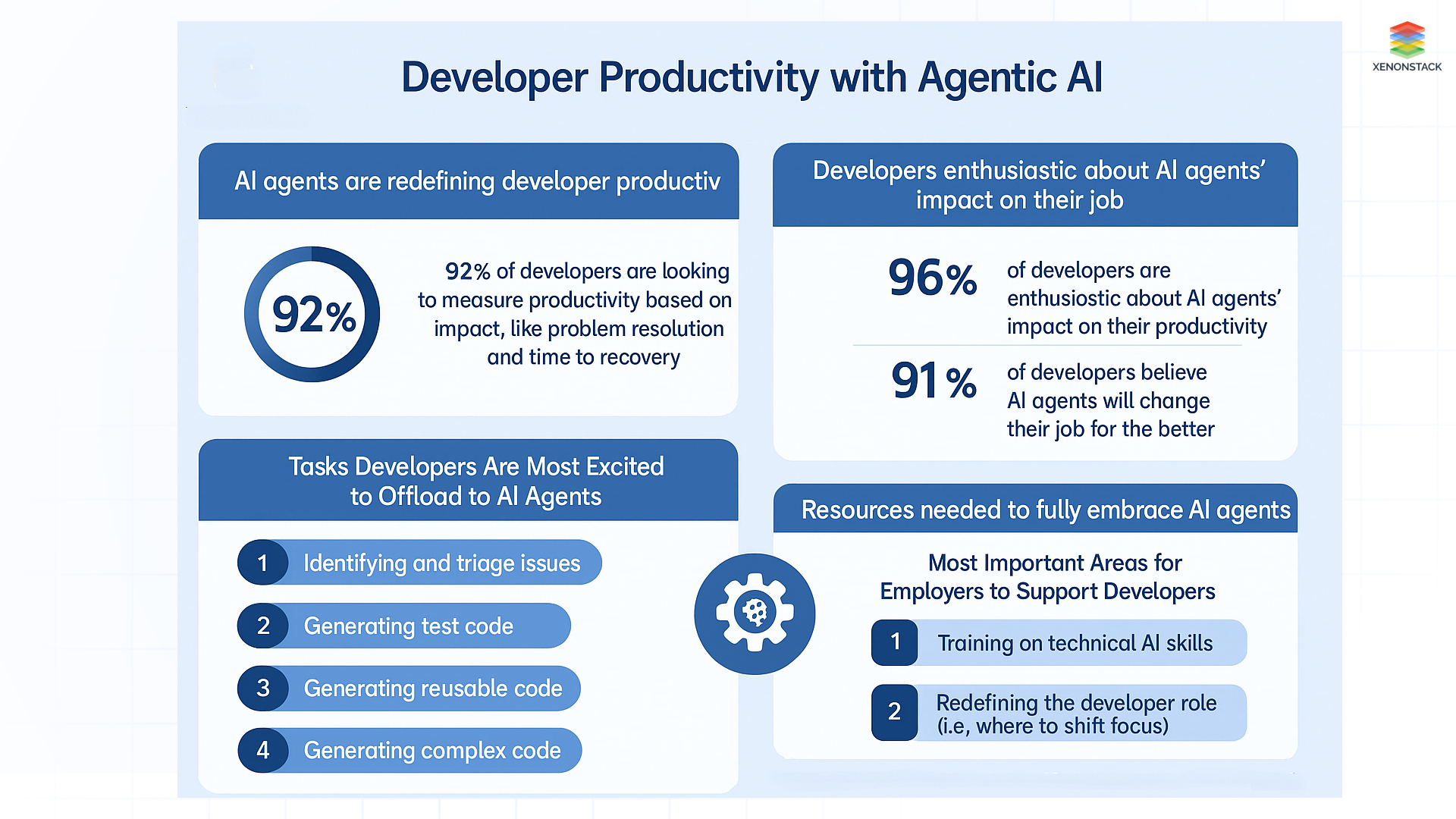Developer Productivity Challenges in the Modern Stack
Despite access to modern tools, developers continue to face recurring obstacles:
-
Tool Overload: Navigating across Jira, GitHub, Confluence, Slack, Jenkins, and other platforms.
-
Legacy Code Confusion: Understanding outdated, undocumented systems.
-
Repetitive Tasks: Manual test writing, boilerplate generation, and routine deployment scripting.
-
Delayed Feedback: Code reviews often become bottlenecks.
-
Security Blind Spots: Insufficient resources to handle vulnerabilities and compliance.
Agentic AI mitigates these pain points with intelligent automation and continuous contextual assistance—allowing developers to focus more on problem-solving and innovation.
 Fig 1: Developer Productivity with Agentic AI
Fig 1: Developer Productivity with Agentic AIKey Agentic AI Capabilities That Elevate Developer Workflows
1. Context-Aware Code Suggestions
Agentic platforms like Google Duet AI and XenonStack AI deliver intelligent, real-time code suggestions tailored to your architecture, business logic, and code history.
2. Automated Documentation and Test Creation
XenonStack Developer Agents enhance code maintenance by:
-
Auto-generating Javadoc, PyDoc, and Markdown documentation
-
Creating robust unit and integration tests
-
Syncing outputs with platforms like Notion, Confluence, and Git repositories
3. AI-enhanced debugging and Live Pair Programming
Tools like GitHub Copilot Chat and XenonStack Debug Assistants allow developers to:
-
Ask natural language queries like "Why is this API failing?"
-
Visualize execution traces and performance hotspots
-
Simulate upstream/downstream impacts before deployment
4. Autonomous CI/CD and DevSecOps Execution
AWS CodeWhisperer and XenonStack CI/CD Agents empower engineering teams with:
-
Self-updating build pipelines
-
Auto-deploy playbooks with rollback capabilities
-
Inline compliance verification (SOC 2, ISO 27001)
-
Code remediation suggestions post-failure
5. Agent-Driven Peer Reviews and Secure Coding
Google Duet AI and XenonStack Secure Agents deliver intelligent reviews:
-
Suggest architectural refactors
-
Scan for known vulnerabilities (e.g., SQL injection, XSS)
-
Ensure license compatibility and third-party compliance
6. Intelligent Onboarding and Knowledge Transfer
Accelerate developer onboarding using:
-
Personalized, AI-curated onboarding journeys
-
Interactive walkthroughs of the codebase
-
AI-driven FAQ and documentation bots trained on internal sources
A joint study by Google and Microsoft reveals that AI-assisted onboarding reduces ramp-up time by over 40%.
Comparison of Leading Agentic AI Platforms
|
Platform
|
Key Features
|
|---|---|
| XenonStack AI | Developer workflow agents, CI/CD orchestration, policy compliance, LLM tracing |
| GitHub Copilot | Contextual code completion, natural language support, IDE integration |
| Google Duet AI | Collaborative coding, live design suggestions, scalable documentation |
| AWS CodeWhisperer | Secure, scalable generation, cross-IDE compatibility, inline policy alerts |
All major platforms integrate seamlessly with environments like VS Code, IntelliJ, Jenkins, GitHub, Bitbucket, and Slack.
Why Agentic AI Is a Strategic Investment for Engineering Teams
Integrating Agentic AI brings tangible benefits across the board:
-
Accelerated Delivery: Slash release times through autonomous build and test cycles.
-
Code Quality Assurance: Minimize bugs and enforce standards using intelligent linting and testing.
-
Reduced Developer Burnout: Offload routine tasks and reduce cognitive load.
-
Seamless Team Collaboration: Streamline handoffs between Dev, QA, and Ops.
-
Scalable Excellence: Replicate engineering best practices across teams, languages, and geographies.
“Agentic AI is like cloning your top engineer and deploying them everywhere—instantly.” — CTO, Global SaaS Enterprise
Measuring ROI from Agentic AI Implementation
Agentic AI isn’t just a technical investment—it delivers business value across operational and human capital dimensions.
Time and Cost Savings
-
30–40% decrease in dev time via reusable code patterns and real-time suggestions.
-
Lower training costs through faster onboarding and self-service documentation.
Productivity Boost
-
Developers reclaim 50–70% of time previously spent on repetitive tasks.
-
AI-generated docs and tests drastically reduce defect rates and tech debt.
Quality and Security
-
Continuous scanning prevents issues from reaching production.
-
Standardized reviews ensure compliance, architectural alignment, and formatting consistency.
Market Agility
-
Automations accelerate response to feature requests and bug fixes.
-
AI-assisted sprint planning enhances delivery accuracy and speed.
Developer Experience
-
Intelligent tooling reduces mental fatigue and repetitive drudgery.
-
Teams report higher morale, engagement, and retention rates.
“Agentic AI gave us an immediate edge—sprint velocity jumped 40%, and new hires were contributing in days.” – VP Engineering, Fortune 500 Cloud Company
Ethical Implications and Governance in Agent-Driven Development
As Agentic AI integrates deeper into engineering workflows, robust governance is essential:
-
Data Privacy: Protecting sensitive code and proprietary logic
-
Auditability: Tracking decisions and changes made by agents
-
Transparency: Understanding how agents generate or refactor code
-
Bias Reduction: Ensuring fairness in code suggestions and review algorithms
Pioneers like XenonStack, Azure AI, and Google Cloud lead by embedding observability, permission layers, and sandbox environments into their agentic platforms.
What’s Ahead for Agentic AI (2025–2026 Outlook)
The next generation of agentic innovation will enable:
-
Multi-agent orchestration across ideation, development, QA, and deployment
-
Voice-command interfaces for coding and environment control
-
Agent-led Agile ceremonies like backlog grooming and estimation
-
Proactive architecture reviews using generative agents
-
Open-source frameworks built on Gemini, Claude, and Mistral models
Companies can build secure, domain-specific AI agent clusters tailored to their product and compliance needs.
Final Thoughts: Engineer Smarter, Ship Faster
Agentic AI isn’t just an enhancement—it’s a revolution. It transforms the way engineering teams work by making development a collaborative, intelligent, and adaptive process. By leveraging platforms such as XenonStack Agentic AI, Google Duet AI, GitHub Copilot, and AWS CodeWhisperer, development teams can unlock:
-
Faster release cycles
-
Higher code quality
-
Stronger security and compliance
-
Seamless cross-functional collaboration
Agentic AI doesn’t replace developers—it empowers them.
.webp?width=1921&height=622&name=usecase-banner%20(1).webp)




